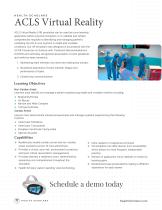
Catalog excerpts

ACLS Virtual Reality ACLS Virtual Reality (VR) simulation can be used as a pre-learning application before physical simulation or to validate and refresh competencies requisite to identifying and managing patient’s exhibiting the ACLS core rhythms in stable and unstable conditions. Our VR simulation was designed in accordance with the ILCOR Consensus on Science with Treatment Recommendations (CoSTR) and nationally recognized resuscitation council guidelines and reinforce team dynamics: 1. Addressing team members by name and making eye contact 2. Situational awareness of team member fatigue and performance of tasks 3. Closed loop communications Learning Objectives Non-Cardiac Arrest: Learners must identify and manage a patient experiencing stable and unstable rhythms including: Bradyarrhythmias AV Blocks ◆ Narrow and Wide Complex ◆ Tachyarrhythmias Cardiac Arrest: Learner must demonstrate situational awareness and manage a patient experiencing the following rhythms: ◆ ◆ ◆ ◆ Ventricular Fibrillation Ventricular Tachycardia Pulseless Ventricular Tachycardia Agonal/ Asystole ◆ Realistically models cardiac arrest and non-cardiac arrest scenarios across 13 core arrhythmias ◆ Provides a virtual, zero-risk, environment to practice and learn critical resuscitation managements ◆ Provides learners a readiness score, determined by assessing core competencies throughout the simulation ◆ Health Scholars’ patent-pending voice technology ◆ Ultra-realistic in-hospital environment ◆ VR simulation can offer learner 24/7 accessibility which allows for more frequent, independent practice ◆ Delivers in application micro-debriefs to reinforce learning gains ◆ Randomized case presentations making a different experience for each learner
Open the catalog to page 1All Health Scholars catalogs and technical brochures
-
Stroke Virtual Reality
1 Pages
-
PASS & RACE Virtual Reality
1 Pages










